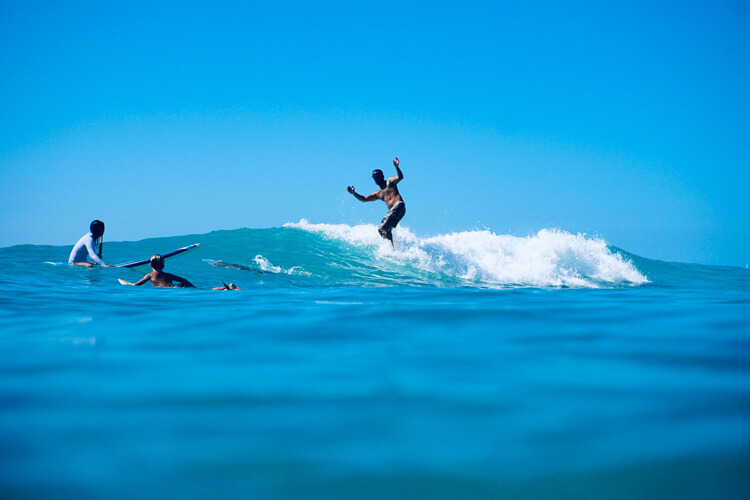The revival of surfing, which took place at the beginning of the 20th century, coincided with the revival of swimming.
Although swimming can be traced back to antiquity and numbers Caesar and Charlemagne among its more famous exponents, the sport had fallen into disrepute during the Middle Ages, as it was thought to be the cause of smallpox epidemics.
When taken up again in the last century, swimming out of doors had transgressed Victorian ideas of morality, and there were many complaints about mixed bathing and the flagrant exposure of naked flesh on the beaches (such as fingers, toes, and necks!)
In 1896 in Athens, Greece, an event took place, which was to set swimming firmly on the map again.
The Olympic Games, revived by Baron Pierre de Coubertin, stimulated a worldwide surge of athletic interest, which from the point of view of Hawaii, reached its zenith when the great Duke Kahanamoku won the gold medal in the 100-meter freestyle swimming event in both the 1912 and 1920 games.
If it had not been for the war, he would undoubtedly have made it three in a row. As it was, he captained the U. S. Olympic team again in 1924.
After analyzing the Duke's success, many swimming coaches were amazed to learn that Hawaiian Islanders had for centuries been using the leg kick, which had revolutionized swimming under the name of the Australian crawl.
This improvement on the Trudgen stroke had been effected by Frederick Cavill, an English immigrant to Australia (in 1887) who had watched the swimming technique of the Australian aboriginals.
Cavill produced six remarkable sons, all of whom became good swimmers.
The oldest, Richard, became a champion and, on returning to England, assured British swimming supremacy for many years.
This tradition was later broken by Charles Daniels of the United States, who had learned the new stroke from another of Cavill's sons, Sidney, who had emigrated to San Francisco.
Daniels eventually developed the so-called American crawl by synchronizing the leg beat with the arm action, thus putting America in the forefront of world swimming, a position which has been held, thanks to Duke and others, with only occasional lapses since that time.
In 1920, the American swimming team included no less than seven Hawaiians. Warren Kealoha, and later on Buster Crabbe and Bill Smith, succeeded the Duke as gold medallists from Hawaii.
All this focused a terrific amount of attention on Hawaii and made the islands a great center for water sports, a fact which was to stimulate the development of surfing considerably in the years to come.
The history of surfing in Hawaii and California is really inseparable, as many of the figures who dominated the sport in one place were also prominent in the other.
Competition between the two areas stimulated many innovations, and new ideas and new methods were rapidly tried out.
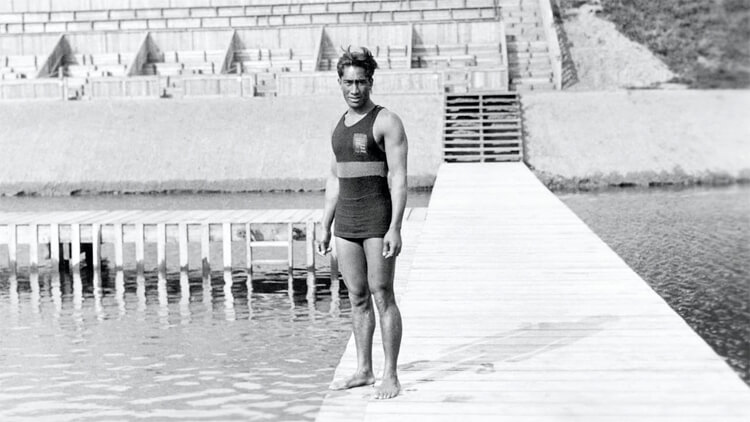
The Rebirth of Surfing
After the re-emergence of surfing from the doldrums at the turn of the century, it was the changing length, shape, and material of the board which influenced the development most.
The ancient Hawaiians used two types of boards, the alaia (thin) board, and the olo (thick) board.
The alaia was used for bodysurfing, but the olo might be 20 feet long and weigh 180 pounds. Large boards were needed to hold 400-pound chieftains.
Boards were made from koa, the sickle-leaved Hawaiian acacia, from the breadfruit, and from other species.
The chiefs often had boards of a light, balsa-like wood called wiliwili, a Pacific relative of the tiger's claw, the symbolic tree of India.
Before the revival of surfing, only small boards were being used, perhaps averaging about six feet in length, and often these were crudely fashioned from old pieces of wood which just happened to be handy.
Surfing techniques were at a low ebb. Surfers merely caught the waves at right angles and rode straight in toward the shore.
In 1907, according to Ben Finney, Caucasians, haoles, white people, or whatever you want to call them, began to participate in surfing.
Previously it had been felt that only Hawaiians could do it.
The boards were soon lengthened and better constructed, and surfers started to slide at an angle across the waves again for increased speed and a longer ride.
One Caucasian surfer, Lorrin A. Thurston, lengthened his board to 12 feet and rode some pretty big waves.
By the irony of circumstances, he was of missionary stock and was the publisher of The Honolulu Advertiser.
Surfers of all races were now using California redwood for their boards.
About this time, the development of Waikiki Beach was proceeding, and the old huts where surfers had kept their boards were torn down.
Soon a solid phalanx of hotels had been stretched along the beach.
To rectify this situation, in the spring of 1908, newcomers from the mainland under the leadership of Alexander Hume Ford founded the Outrigger Canoe Club "to preserve surfing on boards and in outrigger canoes."
They had soon built a large grass clubhouse on Waikiki Beach for the storage of canoes and surfboards, and membership grew rapidly.
(In 1962, it is over 2,000.)
Shortly afterwards, under the inspiration of Duke Kahanamoku, the Hui Nalu Club was formed to encourage surfing among the Hawaiians, and the rivalry between these two and other clubs resulted in paddling races and canoe races, which caught the imagination both of the locals and the tourists who were beginning to frequent the newly-built hotels.
In the 1920s, "Dad" Center, who had become the coach of the Outrigger Canoe Club, staged paddling races on the Ala Wai Canal, where there was no current, so that comparative speeds could be accurately recorded.
In this way, the solid 12-foot Hawaiian board was refined until it was the best in the world at that time and was exported everywhere.
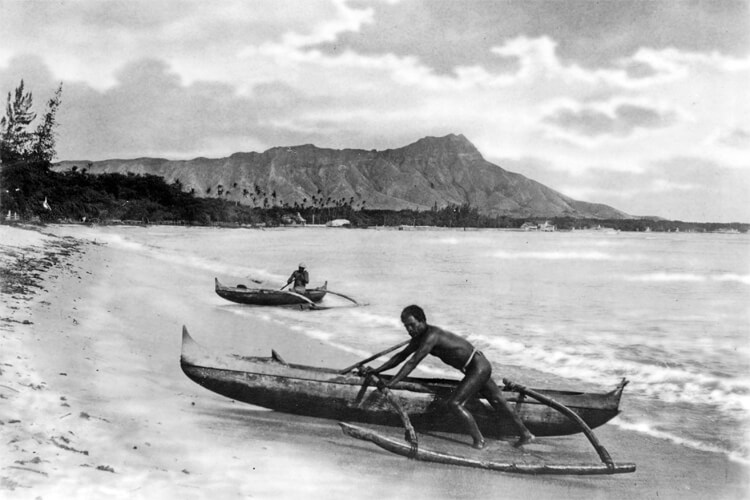
A Brief History of Surfing in California
Meanwhile, let us look at the development of surfing in California, which has dozens of excellent surfing beaches from north of San Francisco to the Mexican border (and beyond, if you consider Baja California).
The Pacific Electric Railway, in an effort to boost ticket sales, is generally credited with the beginning of surfing in California.
In 1907, the company management brought George Freeth, an Irish-Hawaiian, to Redondo Beach.
Freeth was an amazing man who excelled at all water sports. He was an accomplished surfer and water polo player, but he is best remembered for his life-saving feats.
In the famous storm of December 1908, off Santa Monica, he rescued no less than seven fishermen by making three heroic trips through huge freezing cold surf.
George Freeth, by becoming a legendary figure, put surfing on the map in California.
During the same period, that itinerant surfer, Duke Kahanamoku, further set the Californians on their ears by making a fantastic quarter-mile ride at Corona del Mar in 1912.
During the twenties, surfboard races became very popular in California and were held at several points along the coast.
Thomas E. Blake, the world swimming champion between the Duke and Johnny Weissmuller, had designed a board with which he was winning most of these races.
It was a heavy board more than 12 feet long and was well-suited to the rougher California conditions.
In 1928, Blake presented a cup for the Pacific Coast surfing championship and proceeded to win it himself, followed by Preston Peterson, who was later a movie stunt man and one of the finest water sportsmen America has produced.
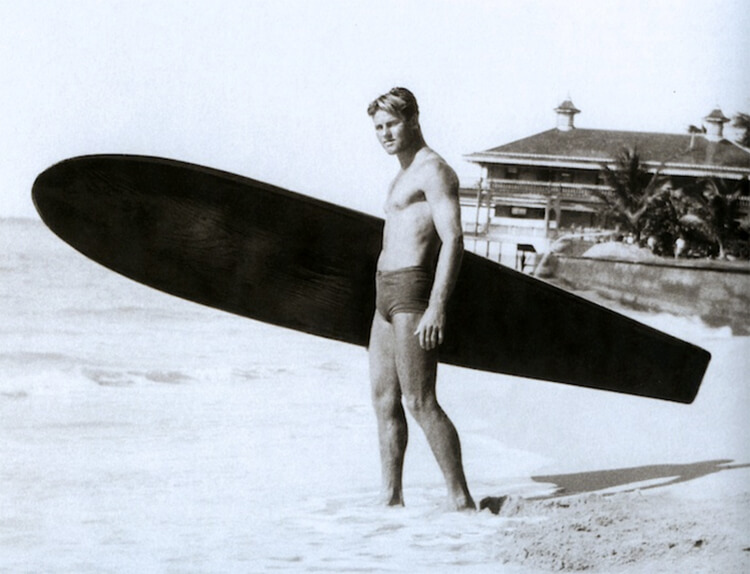
The Paddleboarding Era
In 1930, Tom Blake moved to Hawaii, where he used a 16-foot, solid redwood, 100-pound board, which was pointed at both ends like a cigar and was only 16 inches wide.
Hitherto, the races had been run with boards of a maximum of 12 feet in length with wide bows and tails.
Blake convinced the officials that his new boards should be used and proceeded to set more records on the Ala Wai.
Later, it was found that his board was hollow and almost half the weight of other competitors.
Although Blake had actually broken no rules, the uproar which accompanied this disclosure forced the officials to adopt a no limit for paddleboard races, and from then on, paddleboards were used, which were often 20 or even 24 feet in length and only 16 inches wide.
You had to be big and strong to paddle them, but they generated enormous momentum and had a sustained free-wheeling glide.
Besides Blake, Tom Keakona, Sam Reid, Jack May, and Sam and Duke Kahanamoku were big names in board paddling.
The depression temporarily ended the interest in board racing in Hawaii, but by this time, the hollow board was established for regular surfing since it was easier to paddle and facilitated the catching of waves.
The 1930s also marked a return to the other surfing places on Oahu.
Surfers who had hitherto restricted themselves to Waikiki re-discovered Makaha, Sunset Beach, and Waimea Bay on the north side of the island and several points on the other islands, places where none of the permanent residents were surfing anymore, and yet which once had echoed to the Hawaiian equivalents of "outside" as the ancient Polynesians took to the surf.
In California, the hollow board was widely used for both surfing and paddling, which had a sudden resurgence with Preston Peterson repeating his win in the Blake Trophy (four times altogether), and Blake himself winning the 20-mile marathon from Catalina Island to San Pedro, averaging four miles per hour.
Numerous top-class surfers developed in California in this period, among them Hobie Alter, Dale Velzy, Adolph "Adie" Bayer, Leroy Grannis, Cliff Tucker, and Lorrin Harrison.
Many of them are now making surfboards or are taking surf photographs.
This period also produced the famed Gene "Tarzan" Smith, undoubtedly the greatest marathon paddler of all time.
Hailing from Balboa, California, he came to Hawaii in 1936 and would often paddle several miles out to sea from Waikiki, way out of sight over the horizon, just for an afternoon's amusement.
In 1938, he paddled from the island of Molokai to Makapuu, Oahu, in 8 hours and 15 minutes, a distance of about 26 miles, but this turned out to be no more than another training spin.
At 3:45 pm, October 14, 1940, he left Kaena Point, Oahu, on his 13-foot, 90-pound board and almost reached Koloa, Kauai, the following day, having covered more than 70 miles in 30 hours in quite heavy seas.
Two small vessels accompanied him on this heroic saga.
On the way, he was severely stung by schools of Portuguese man-of-war (coelenterates with stinging tentacles).
As he approached the island of Kauai, a huge manta ray 12 feet across blocked his way, and had to be shot four times before he could continue.
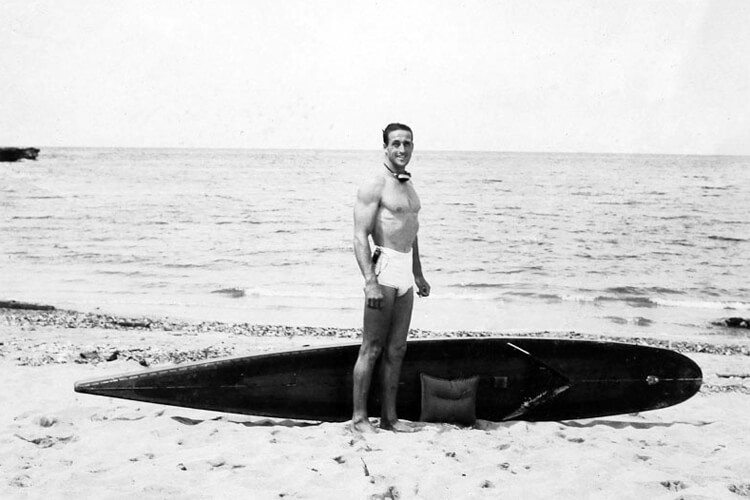
A Surfboard Revolution
In the early 1930s, balsa wood boards began to enter the picture, and there was a general return to the Hawaiian-type boards.
These had the wide (8 to 14 inches) nose and tail, which were conducive to more stability than the pointed boards.
The first balsa-type boards weighed about 60 pounds and were laminated with spruce or redwood.
These boards were about 11 feet long and, like the older redwood boards, were very stable once they had been gripped by the wave - men could ride them with a fine arrogance standing as erect and still as statues.
Stronger surfers could also force their way through quite large waves without losing their boards.
But all these early boards turned sluggishly, which in the fast, short breaks of the California coast often meant the loss of a ride.
Everything seemed to point to the need for more lightness, so in the early 1940s, the all-balsa board, weighing about 40 pounds, was developed, and it soon became very popular in California and later in Hawaii.
The surface of this board was coated with plastic or fiberglass.
Formerly a varnish finish had been used, which required instant repairs for the slightest dent, or seawater would enter and cause the wood to rot.
The plastic covering was far more resistant to abrasion of any kind and would even stand up to minor collisions.
Finally, this new board, called the Malibu, was fitted with a skeg or tail fin, a device which had been invented by Tom Blake in 1935.
In the ensuing decade, Bob Simmons, a young Californian of exceptional ability, really worked over the design of surfboards.
Bob was a scientist trained at CalTech, and in his backyard, in Pasadena, he studied the fluid dynamics of the relationship between the board and the wave.
He was the first to shape the top as well as the bottom and was the first to put a real turn-up on the boards.
He simultaneously improved their appearance as well as their balance and stability.
Simmons was a dedicated surfer who eventually lost his life while surfing. Some say he was hit by his own board.
He was last seen swimming in the rip tide produced by a period of big surf off Windansea, La Jolla.
His body was recovered days later when the surf had stopped running.
The Malibu board, with its many innovations, once more set California in front of the surfboard design race, a position which has never been lost.
In the 1950s, it was only a step from the light, fast, maneuverable balsa-wood board to the even more-so foam or polyurethane board, first made by Matt Kivlin, which is now in almost universal use throughout the surfing world.
The liquid plastic is poured into a mold, where the reaction of the constituents causes the board to harden under pressure.
The cooled slab is then shaped and sanded as required by the purchaser.
For reinforcement, balsa strips are usually added in the mold, and a fiberglass finish completes the job.
The average weight of the "foamies," or "ponies" as they are called in Australia, is only about 25 pounds, and maneuvers can be quickly learned on them, which took the old surfers years to master on the heavier boards.
Post World War II Renaissance
During the Second World War, surfing had come to a standstill, and at the end, most of the old-timers had put away their boards for good.
It remained for a new generation to take over.
After the war, it was found that some of the famous surfing spots in California had been lost to breakwaters.
Corona del Mar was one, and Long Beach was another, although, in Hawaii, an excellent new location called Ala Moana was inadvertently formed between Hawaiian Village and the Honolulu Yacht harbor by the dredging of the harbor entrance through the reef.
In 1947, the Waikiki Surf Club was started to look after the younger surfers since the Outrigger Club had "gone posh" and had become expensive, and the Hui Nalu was now concentrating on outrigger canoe racing.
Rental boards, complete with instructors, started to appear on Waikiki Beach so that tourists and co-eds could try out the surf.
The log-jam on a summer's day has to be seen to be believed.
California beaches too had a steadily increasing population, and beaches like Malibu, which had once supported only a handful of dedicated surfers, soon became impossibly crowded.
The great expansion was on, stimulated by the growing reservoir of board makers who, from being members of a rather rare and special species, now sprang up on every corner.
They were later aided by the surf movie makers.
This typical surfing phenomenon had been started in the late 1930s by bodysurfer Bud Browne, who has made surf movie-making his life's work.
He lives in a garage attic and eats one meal a day to make this possible.
With Greg Noll, Walt Phillips, Don and Bruce Brown, John Severson, Grant Rohloff, and several others swelling the ranks of surf movie-making, surfing received increasing publicity.
This was well deserved since the color films they produce are of an uncommonly high standard.
Surfing began to spread with geometric progression, and the number of surfers doubled every year.
From a few hundred post-war surfers, there are estimated to be 40,000 in California alone and a rapidly growing number in the rest of the world.
Eventually, even the more difficult surfing spots in California became crowded.
Some of the newer old-timers put away their boards, and again some moved to Hawaii as their predecessors had done in the 1930s.
But this time, the new generation was already surfing.
For every surfer quitting, there were 10 to take his place, and with them expanded the relatively small but noisy section of hoodlums and delinquents (ho-daddies and gremlins) who have, in most cases unfairly, given the entire surfing fraternity a bad name.
Of those surfers who moved to Hawaii, some took jobs; others set up a nomad existence, sleeping in the backs of broken-down station wagons, painted in fearful shapes and colors; they cooked over campfires, eating, sleeping, and talking surfing.
On the island of Oahu, Makaha, Pupukea, Waimea Bay, and Sunset Beach suddenly began to receive a great deal of attention, mostly from these California transplants, who continue to ride bigger and more impossible waves as time fines on.
Sunset Beach on a Saturday in November is beginning to look like Waikiki, and as more people ride the big ones, the less awe-inspiring they appear - until you try one yourself!
In 1954, thanks to the efforts of John Lind and the Waikiki Surf Club, the International Surfing Championships at Makaha were started.
(Originally, the Waianae Lions Club were co-sponsors of this meet, but they have since dropped out.)
In that first year of the competition, George Downing, the famous coach of the Outrigger Canoe Club, won the senior men's division.
Points are awarded on length of ride, the number of waves caught, grace, skill, and sportsmanship.
Rabbit Kekai, Conrad Canha, Jamma Kekai, Peter Cole, Wally Froiseth, Buffalo Keaulana, and again George Downing (1962) were subsequent winners so that by far the highest proportion of winners were island-born.
Ethel Kekua (twice), Marge Calhoun, and Linda Benson have all won the women's division.
Girl surfers increased in numbers since the invention of the light board made paddling easier for them. There is also a junior men's and a tandem division at Makaha.
In California, one of the main surfing events is the Catalina Island - Manhattan Beach marathon paddle which was started by Tom Blake.
In the last few years, it has been won no less than five times by the redoubtable Tom Zahn.
Other surfing and paddling contests are held regularly at several of the more prominent surfing beaches of California, and surfing clubs are beginning to sprout all over.
The contest at Huntington beach is becoming as big and important as that at Makaha.
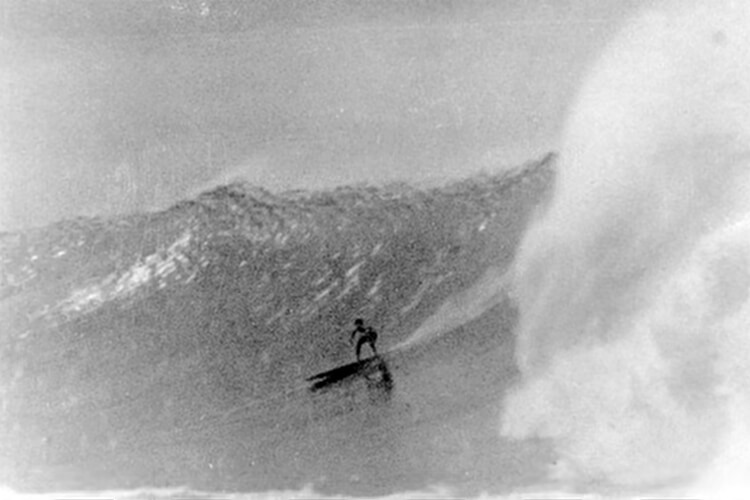
An Ever-Growing Water Sport: The Australian Surf Fever
There is no end to the potential growth of surfing, but undoubtedly, as time goes on, more controls will have to be imposed on the sport.
Both surfers and the public need protection, and perhaps the United States Surfing Association, organized by Brennan McClelland, will provide this.
By 1970, at the present rate of growth, there will be well over 200,000 surfboards on the West coast alone, and the present beaches cannot support such numbers.
At the same time, what with wetsuits and paddleboards to widen the surfing scope, it is likely that every lake, river, and seacoast in existence will sooner or later find itself the area for some kind of surfing and the mystic thrill of a ride on the sea's race will be able to help yet another generation of surfers find their place in the sun.
Surfing in Australia has had a very different development from that in California and Hawaii.
The Australian continent possesses thousands of miles of fine beaches, and while the surf is mostly wind-produced and is often irregular, it extends in a continuous line down the East coast with many different types, varying from reefs to shore breaks and sand bars, so that the opportunities for bodysurfing especially are endless.
When you combine this situation with an athletic, sports-loving population, it is not surprising that swimming and bodysurfing are far more popular on a per capita basis in Australia than anywhere else on earth.
Tommy Tanna, a Polynesian gardener, is given credit as the first man to bodysurf near Sydney.
He caused a sensation as he barreled in on the crest of a breaking wave and soon had hordes of imitators.
The sport spread very quickly, and because of the adventurous spirit prevailing at the time, coupled with the danger of the heavy surf, quite a few lives were lost.
This gave rise to the Surf Life Saving Association of Australia, a voluntary series of clubs whose membership runs close to 20,000.
The clubs themselves frequently engage in competition at surfing carnivals which are most spectacular when the surf is running high.
In this way, Australian methods of life-saving are constantly being refined and have since been adapted in other areas of the world.
These clubs are financed by a method which is surely unique.
There is little subsidy from government sources to the Surf Life Saving Association, although there is a $5 annual license fee for each surfboard, which helps in a small way toward the club's upkeep.
Apart from this, unlike most organizations run for the public benefit, the club members themselves are charged dues so that, in reality, they pay for the privilege of ensuring safety on the beaches.
These public-spirited citizens are credited with no less than 120,000 rescues since the beginning of the century.
Board surfing in Australia is comparatively recent.
In 1915, the irrepressible Duke Kahanamoku visited Australia to compete in the New South Wales championship swimming meet.
Using his own board, which he himself had fashioned from solid sugar pine, he turned on a dazzling display of surfboard riding, turning, sliding, and kicking out of the waves with what seemed like astonishing ease.
This was at Freshwater Beach, Sydney, where the Duke's name is still mentioned with awe, and the local surf club still has his famous board on permanent show in their clubhouse.
This board and the Duke's technique of the time were copied by thousands of eager surfers, and surfboard riding in Australia was well and truly launched.
The first Australian board championship was held just after the first World War and was won by Claude West.
The development of boards for a long time followed the California pattern with emphasis on speed and length (up to 20 feet).
Paddling races were held as part of the surf carnivals.
In 1933, Dr. G. A. Crackenthorp of Manly Surf Club, Australia, invented the surf ski, which has since become standard life-saving equipment down under, second only to the surf boats in usefulness.
These surf skis vary greatly in size, averaging 15 feet by two feet by six inches and weighing around 50 pounds.
They are constructed of 3/16 inch marine plywood with cedar sides.
They are pointed at each end. A seven-foot paddle is used, which makes negotiation of the waves on the way out much easier.
Surf ski races are common in Australia, but for these, skis much longer and more slender than the average are used.
In December 1956, I was fortunate enough to witness one of these surf ski races at the International Surf Carnival at Torquay near Melbourne, Australia, and a terrific sight it was.
These young men, who were all fine physical specimens, were tearing flat out into huge broken waves and paddling like dervishes in their efforts to be the first round the buoy.
On the way back, they would keep up the paddling until a wave caught them, and then they would slide back to bring the nose of the ski up as it came threshing in through the choppy waters of the uneven surf.
In spite of its exciting possibilities and advantages, the surf ski is only seldom seen in other surfing areas and has remained a typically Australian surfing phenomenon.
Today it is becoming less popular still since polyurethane boards are taking over.
Peter Lawford was the first to bring the Malibu board to Australia in 1954, but it was greeted with a lukewarm reception, and it took Tom Zahn, Greg Noll, and other American lifeguards at the Melbourne Olympic Games in 1956 to demonstrate its full potential.
Much to the delight of the locals, Tom Zahn also took out the Duke's old sugar pine board at Freshwater Beach and repeated the latter's performance of 40 years ago.
The Malibu board gained favor rapidly and is now in wide current use in Australia, and because of its lightness and maneuverability, surfing is very much on the increase there.
Board builders who three years ago produced 1,500 boards per annum are now finishing 5,000 boards every year.
The total number of surfers of all kinds in Australia is estimated at between 30,000 and 40,000.
There are two features of Australian surfing which are worth noting. One is the fear of sharks, which are a problem at least on all coasts.
They are apparently most menacing in the early morning or late evening, and most attacks take place in the hot summer months (December to March) when the food supply of schooling fish is low.
Shark patrol boats lay nets across the more populated beaches, and shark attacks in these areas are negligible.
Once a shark is caught in the net, the others keep away.
Sharks abound in Queensland's tropical waters, however, and in this and all other states except New South Wales, there are no nets - so be warned.
Despite the shark menace, there have been only 48 authenticated shark attacks since surfing started in Australia, and John Bloomfield, the noted Australian surfing authority, gives the odds against being attacked by a shark the same as winning first prize in four successive lotteries.
However, shark attacks are, for some reason, more frequent in Australia than in other surfing areas of the world. Even in those States with few surfers, attacks are on the increase.
The other feature which is well worth noting is the much lower proportion of delinquents and hoodlums among the Australian surfing fraternity.
The excess energy and need for identity, which has given such a bad name to surfers in many parts of California, is channeled into the life-saving clubs in Australia, whose members are respected and even looked up to by the whole community.
It is a great pity that a similar situation does not exist in California.
(Note: Unfortunately, with the advent of the polyurethane board, even in Australia, surf life-saving membership is on the decrease, and hoodlums are on the increase!)
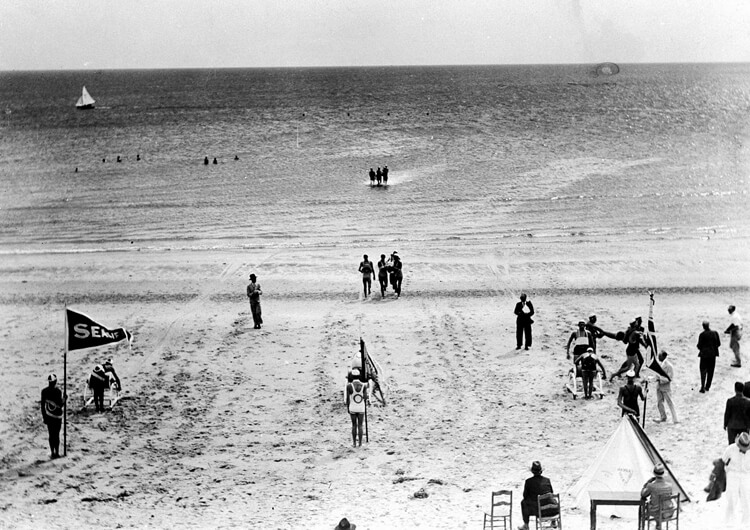
Surfing Around the World
Peru: There are two well-developed clubs called Waikiki and Kon-Tiki near Lima, the capital city. Since 1954, international meets have been held there.
In 1955, George Downing rode Kon-Tiki on a balsa board and showed the Peruvians the big wave survival stance. Previously the Peruvians had not ridden the big waves.
The surf is very consistent due to the perpetual storms from Antarctica, and on most days, both large (8 to 18 feet) and small waves are available.
Peruvian surfing beaches are among the world's best, so that surfing enthusiasm is quite naturally growing by leaps and bounds.
Hector Velarde was the winner of the 1962 Peruvian contest, which included teams of contestants from California, Hawaii, France, and Australia.
Mexico: Besides Baja California, there is good surf but few surfers, at Mazatlan, San Blas, Manzanillo, Puerto Vallarta, and at many other places on the long Mexican coastline.
In fact, plenty of room exists for the "Alta" California overflow. Living costs are extremely low.
South Africa: Durban is the center with surf up to 30 feet on occasions. Surfing was started in the late 1930s by a visiting Australian.
There is now a surf club at South Beach, but there is good surf at many other places on the South African coast.
New Zealand: Surfing was re-started here in the 1930s. The Maoris, who are Polynesians, had not kept the sport alive.
Polyurethane boards have caught on in New Zealand, and the thousands of miles of surfable coastline are currently being explored, with surfing very much on the increase.
France: Screenwriter Peter Viertel (Deborah Kerr's husband) brought a Malibu board to Biarritz in 1956.
Now there are over 100 surfers and many good surfing beaches. Club Waikiki has already held a surfing contest.
Israel: Doctor Dorian, originally of San Diego and a practicing physician in Honolulu, introduced the sport there. A surf club is now operating.
Oregon: Surfing is reported from several beaches. Wetsuits are needed in the 45-60 °F water.
East Coast, USA: Daytona Beach, Florida, Virginia Beach, Virginia, Jones Beach, New York, many beaches in New Jersey, and other states have good surf with an expanding number of surfers.
There are also reports of surfing from England, Canada, Ceylon, India, West Africa, North Africa, Chile, Brazil, Formosa, and Malaya, and quite a few isolated islands in the various oceans of the world.
Words by Desmond Muirhead | Golf Course Designer and Author of the Book "Surfing in Hawaii" (1962)
Chapter II of "Surfing in Hawaii" was published under the authorization of Rosemary J. Muirhead, one of the three daughters of Desmond Muirhead
